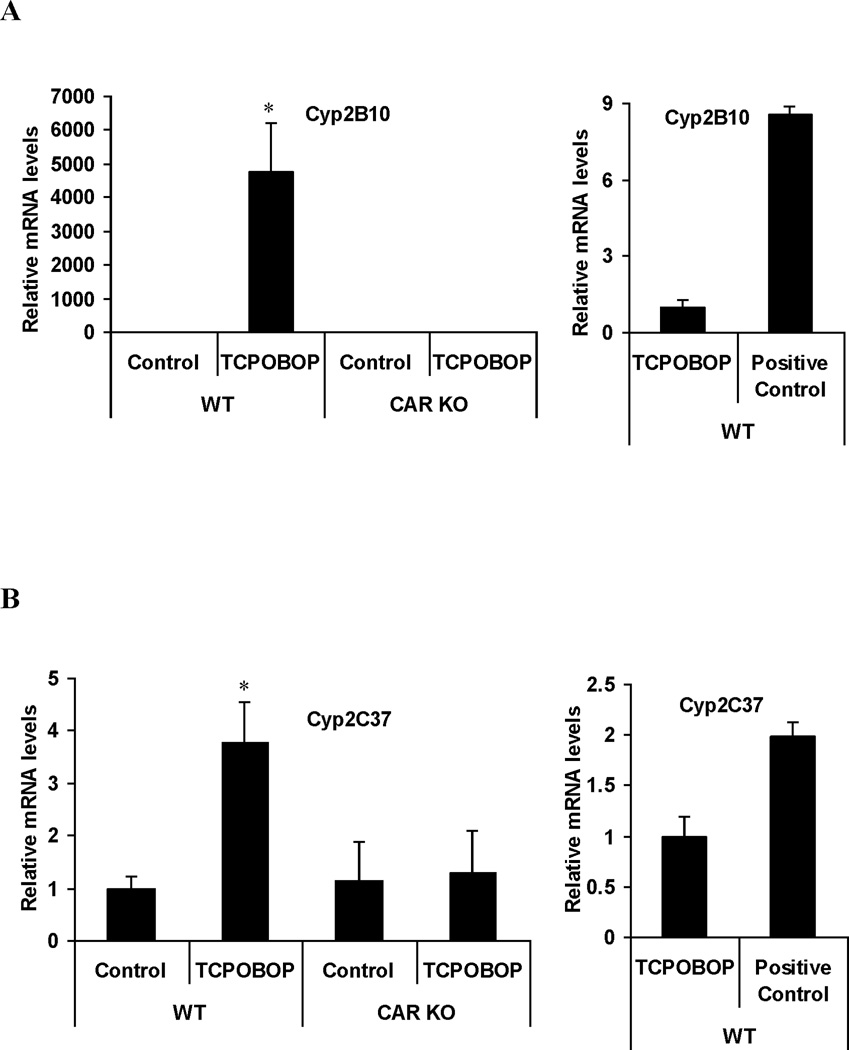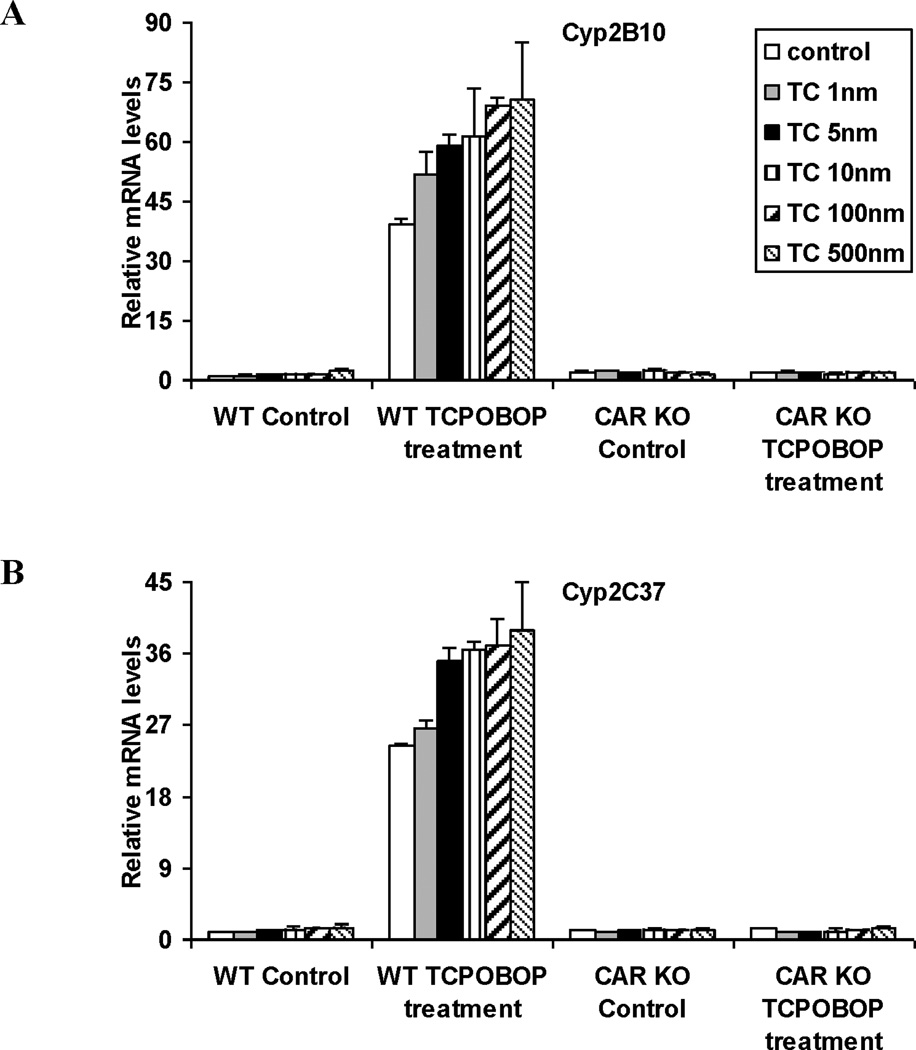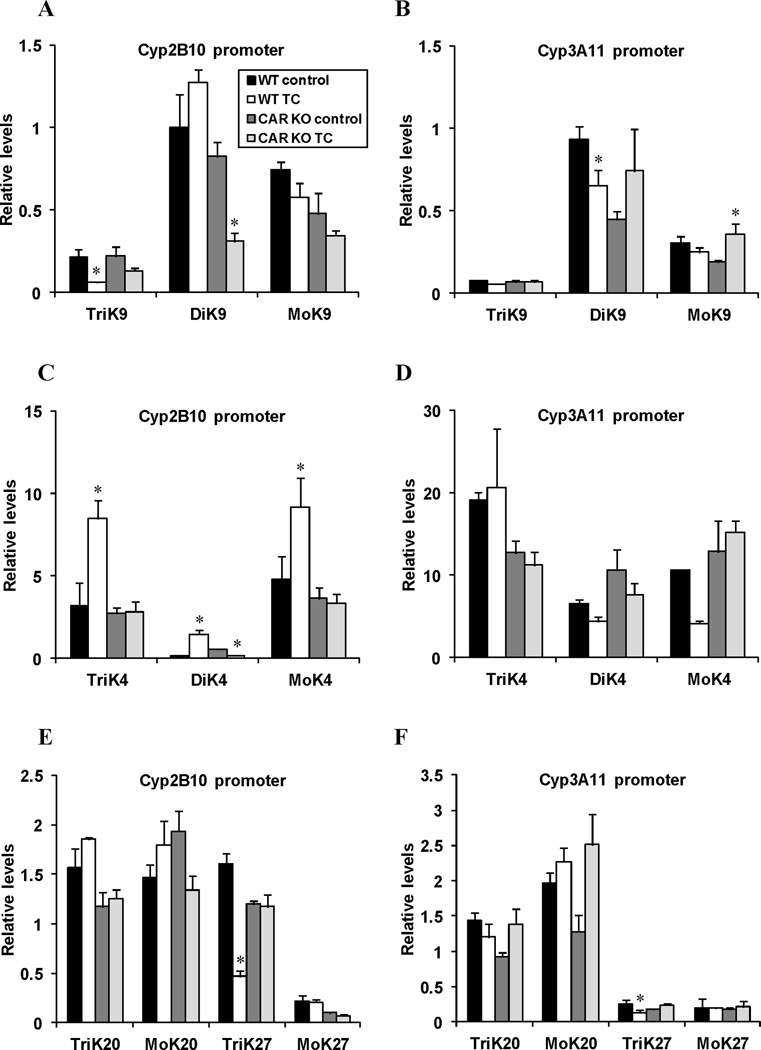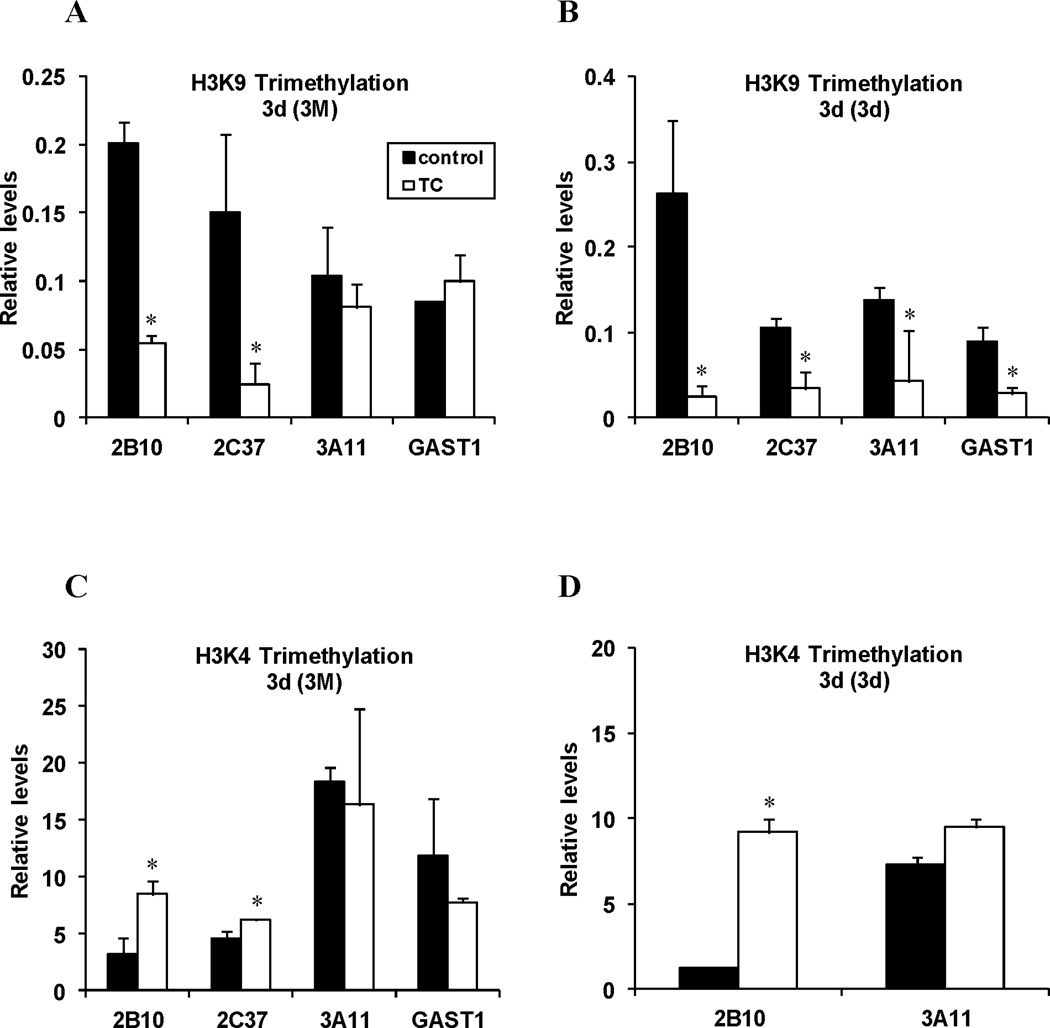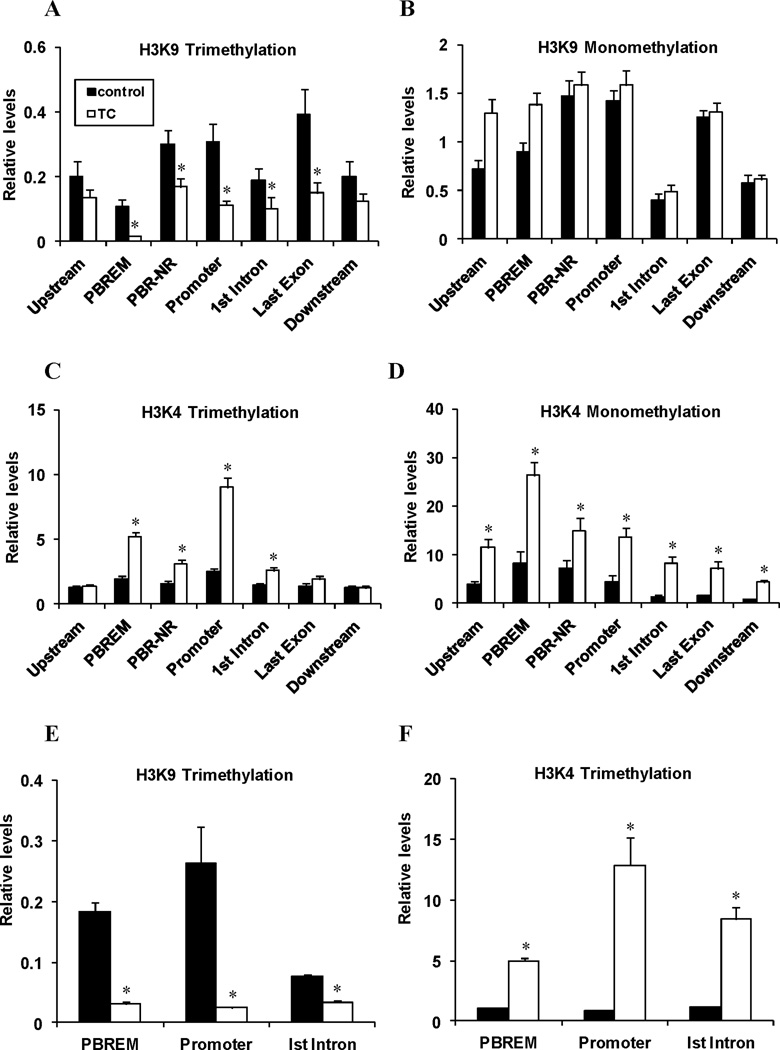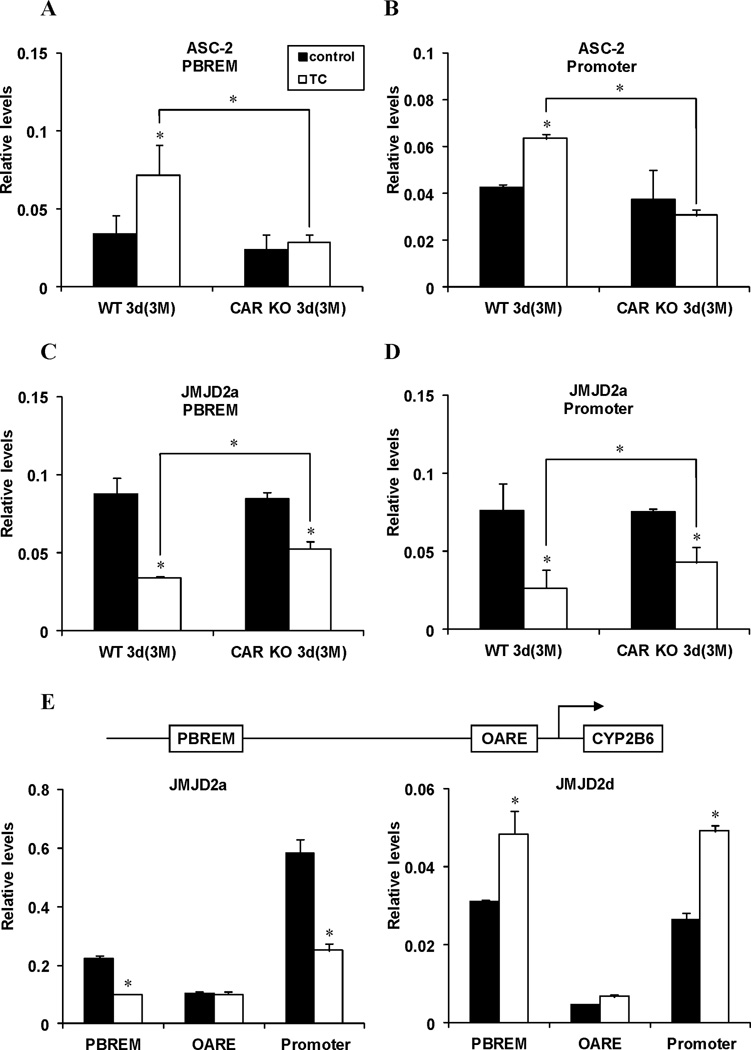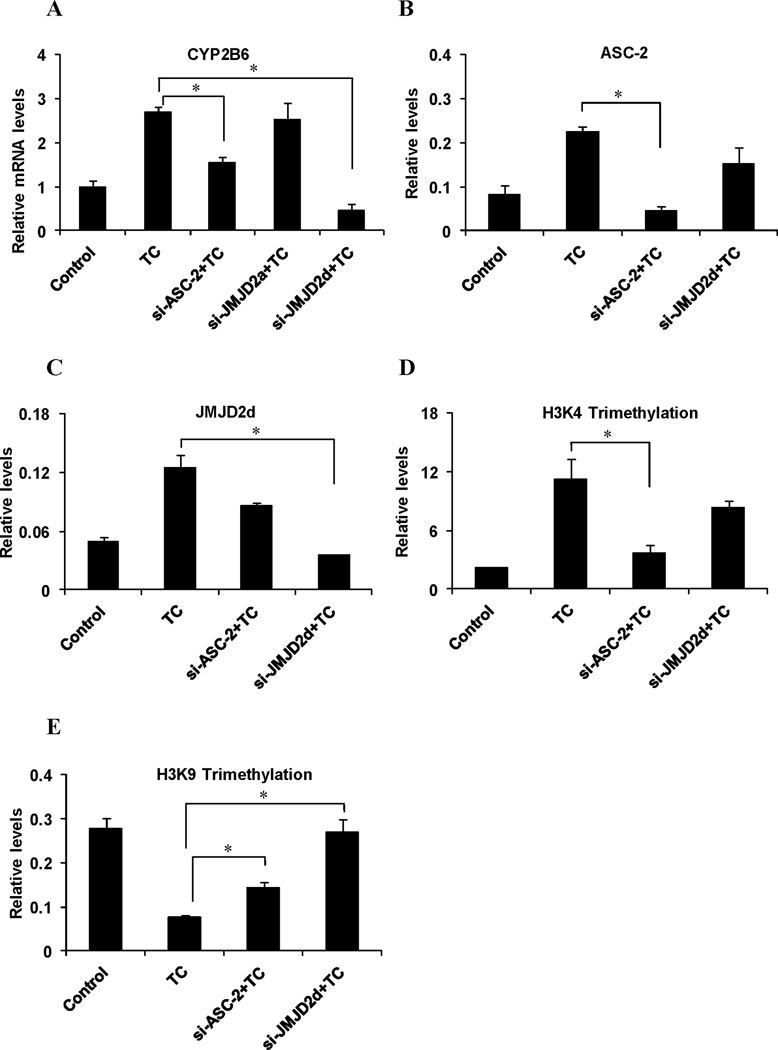Abstract
Aberrant epigenetic alterations during development may result in long-term epigenetic memory and have a permanent effect on the health of subjects. Constitutive androstane receptor (CAR; NR1I3) is a central regulator of drug/xenobiotic metabolism. Here, we report that transient neonatal activation of CAR results in epigenetic memory and a permanent change of liver drug metabolism. CAR activation by neonatal exposure to a CAR-specific ligand, 1,4-bis[2-(3,5-dichloropyridyloxy)] benzene (TCPOBOP) led to persistently induced expression of the CAR target genes Cyp2B10 and Cyp2C37 throughout the life of exposed mice. These mice showed a permanent reduction in sensitivity to zoxazolamine treatment as adults. Compared with control groups, the induction of Cyp2B10 and Cyp2C37 in hepatocytes isolated from these mice was more sensitive to low concentrations of the CAR agonist TCPOBOP. Accordingly, neonatal activation of CAR led to a permanent increase of histone 3 lysine 4 (H3K4) mono-, di- and trimethylation and decrease of H3K9 trimethylation within the Cyp2B10 locus. Transcriptional coactivator ASC-2 and histone demethylase JMJD2d participated in this CAR-dependent epigenetic switch.
Conclusion
Neonatal activation of CAR results in epigenetic memory and a permanent change of liver drug metabolism.
Keywords: CAR, nuclear receptor, epigenetic memory, drug metabolism, histone methylation
Introduction
Epigenetic modifications play important roles in controlling gene expression and orchestrating various biological processes such as cellular differentiation and physical integrity of genome 1, 2. It is widely accepted that epigenetic process is one of the underlying mechanisms that leads to developmental plasticity 3–5. Aberrant epigenetic alterations at early-life stages, mediated by environment and stochastic events such as drugs or xenobiotics exposure, may cause epigenetic memory, which probably induces aberrant gene expression throughout an individual’s life span and have a permanent effect on the risk of certain diseases during later life 1, 6, 7–9.
The constitutive androstane receptor (CAR, NR1I3), a central regulator of drug/xenobiotic metabolism in liver, is a member of the nuclear hormone receptor superfamily of ligand-activated transcription factors 10, 11. In response to specific xenobiotic or endobiotic inducers, CAR translocates from the cytoplasm to the nucleus and binds to the phenobarbital-responsive enhancer module (PBREM) as a heterodimer with its partner, retinoid X receptor (RXR, NR2B1) to regulate the levels of various gene transcripts involved in liver drug metabolism in response to a variety of therapeutic agents 12–17. Epigenetic changes at the promoter of the CAR target gene Cyp2B10 after CAR activation have been reported 18. However, after clearance of CAR activators in the liver, CAR is inactivated and the expression of its target genes returns to basal levels.
In the current study, we demonstrate that, in mice, transient activation of CAR by neonatal exposure to the specific CAR agonist 1,4-bis[2-(3,5-dichloropyridyloxy)] benzene (TCPOBOP) results in long-term epigenetic memory. These mice showed persistently induced expression of the CAR target genes Cyp2B10 and Cyp2C37 throughout their life, and displayed a permanent change of drug metabolism.
Materials and Methods
Reagents
TCPOBOP was purchased from Sigma Chemicals (St. Louis, MO) and Zoxazolomine (2-amino-5-chlorobenzoxazole) was obtained from Bioscience (Ellisville, MO).
Animal treatment
Wild type (WT) C57Bl/6 mice and CAR−/− mice 10 on the third day after birth were injected intraperitoneally with a single dose of either corn oil (vehicle) or TCPOBOP (3 mg per kg body weight) (3–5 mice per group). At 12 weeks after injection, mice were sacrificed, and livers were removed for gene expression and chromatin immunoprecipitation (ChIP) assays. As positive control, 12-week-old WT mice were pretreated with TCPOBOP. On the third day after treatment, these mouse livers were collected for gene expression analysis.
Zoxazolamine paralysis assay
Twelve-week-old mice (with neonatal exposure to corn oil or TCPOBOP) were administered a single intraperitoneal injection of zoxazolamine (250 mg per kg body weight), and paralysis time was measured as described previously 10. Mice were placed on their backs and paralysis time was defined as the time required for they being able to consciously right themselves. As positive and negative controls, 12-week-old WT and CAR−/− mice were pretreated with TCPOBOP. On the third day after treatment, these mice were given a single injection of zoxazolamine and paralysis time was measured.
Primary hepatocyte culture
Primary hepatocytes from 12-week-old male mice were prepared as described previously 19. Hepatocytes were treated with TCPOBOP (1–500 nM) for 24 h prior to RNA isolation.
RNA isolation and quantitative real-time PCR
Total RNA was isolated from mouse livers or primary hepatocytes using Tri-Reagent (Molecular Research Center, Inc., Cincinnati, OH). Quantitative real-time PCR was performed as described previously 20, 21. Amplification of β-actin was used as an internal reference. β-actin primers were obtained from Ambion, Inc. (Austin, TX). Primer sequences are listed in Supporting Table 1.
ChIP assays
ChIP assays were performed according to the protocol of a kit (Upstate, Lake Placid, NY). DNA was purified by one extraction with phenol-chloroform followed by ethanol precipitation and used for quantitative real-time PCR. Anti-trimethylated histone 3 lysine 4 (H3K4), anti-dimethylated H3K4, and anti-monomethylated H3K27 antibodies were purchased from Millipore (Temecula, CA). Anti-monomethylated H3K4, anti-trimethylated H3K9, anti-dimethylated H3K9, anti-monomethylated H3K9, anti-trimethylated H3K27, anti-trimethylated H3K20, anti-monomethylated H3K20, and anti-JMJD2c antibodies were purchased from Abcam (Cambridge, MA). Anti-JMJD2a and anti-activating signal cointegrator-2 (anti-ASC-2) antibodies were purchased from Bethyl Laboratories (Montgomery, TX), anti-JMJD2b antibody was purchased from Cell Signaling (Danvers, MA), and anti-JMJD2d antibody was purchased from Abgent (San Diego, CA). Sequences of the primers used for ChIP assays are available upon request.
Statistics
All data represent at least three independent experiments and are expressed as the mean ± SD. Student’s t test was used to calculate P values. P less than 0.05 was considered significant.
Results
Transient activation of CAR on the third day after birth causes permanently induced expression of the CAR target genes Cyp2B10 and Cyp2C37 in mouse liver
Drug-mediated CAR activation during development may result in a persistent change of its target gene expression. To test this hypothesis, mice on the third day after birth (neonates) were administered a single intraperitoneal injection of either corn oil or the specific CAR agonist TCPOBOP. At 12 weeks (adult) after injection, these mice were sacrificed and the mRNA levels of 21 target genes of CAR in liver were examined (Supporting Table 1).
Compared with control groups, neonatal exposure to the CAR agonist resulted in a 4750-fold induction of Cyp2B10 and a 3.8-fold induction of Cyp2C37 in adult WT mouse livers (12-week-old). Deletion of the CAR gene (CAR−/−) completely abolished the induction of these genes (Fig. 1). In response to transient activation of CAR on the third day after birth, the up-regulation of Cyp2B10 and Cyp2C37 was also observed in aged (23-month-old) WT but not CAR−/− mouse livers (data not shown). These data indicate that transient activation of CAR by neonatal exposure to TCPOBOP specifically induces the expression of the CAR target genes Cyp2B10 and Cyp2C37 in mouse livers throughout their lives.
Fig. 1. Neonatal CAR activation specifically induces hepatic Cyp2B10 and Cyp2C37 mRNA levels in 12-week-old mice.
WT and CAR knockout (CAR KO) mice were injected with either TCPOBOP or corn oil (vehicle) on the third day after birth (3–5 mice per group). Liver total RNA was isolated when mice were 12-weeks old. Cyp2B10 (A) and Cyp2C37 (B) mRNA levels were measured by real-time quantitative PCR and normalized to β-actin mRNA levels. As a positive control, 12-week-old WT mice were pretreated with TCPOBOP. On the third day after treatment, these mouse livers were collected for gene expression analysis (right). Data are expressed as fold change over the control (left) or neonatal exposure to TCPOBOP (right). *P < 0.05 versus control group.
In addition, the expression levels of these genes in adult mice that were neonatally exposed to TCPOBOP were compared with those in adult mice pretreated with TCPOBOP three days before RNA isolation. Twelve-week-old mice were treated with a single dose of TCPOBOP, which dramatically induced the expression of Cyp2B10 and Cyp2C37 in liver. Levels of Cyp2B10 and Cyp2C37 were 8.6-fold and 2.0-fold, respectively, higher than those caused by neonatal exposure to TCPOBOP (Fig. 1).
Neonatal CAR activation results in permanently increased drug resistance in mouse livers
We then asked whether this persistent induction of CAR target genes resulted in a physiological increase in drug clearance. The muscle relaxant zoxazolamine, a substrate of several cytochrome P450 enzymes, is a simple indicator of drug clearance 10, 35. Decreased zoxazolamine-induced paralysis time indicates induction of cytochrome P450 enzyme activities and increased metabolic inactivation of this compound. Compared with control groups, neonatal CAR activation significantly decreased zoxazolamine-induced paralysis time (from >12 h to less than 1 h) of adult WT but not CAR−/− mice (Table 1). CAR−/− mice exhibited a longer paralysis time compared with WT mice with or without neonatal CAR activation. These results indicate that transient activation of CAR during the neonatal stage results in permanently increased drug resistance in mouse livers.
Table 1.
Zoxazolamine paralysis test
| Treatment | Survival | Mean paralysis time | ||
|---|---|---|---|---|
| Male | WT | Control/corn oil | 5/5 | >12h |
| TCPOBOP | 4/4 | 43min±26min | ||
| CAR KO | Control/corn oil | 5/5 | >12h | |
| TCPOBOP | 4/5 | >12h | ||
| Female | WT | Control/corn oil | 5/5 | >12h |
| TCPOBOP | 3/3 | 55min±51min | ||
| CAR KO | Control/corn oil | 5/5 | >12h | |
| TCPOBOP | 5/5 | >12h | ||
WT and CAR knockout (CAR KO) mice were injected with either TCPOBOP or corn oil (vehicle) on the third day after birth. When mice were 12-weeks old, these mice were given a single intraperitoneal injection of zoxazolamine (250 mg/kg body weight). Paralysis duration was recorded as the time when the mice were able to right themselves repeatedly (3–5 mice per group).
Hepatocytes from adult mice with neonatal CAR activation are more sensitive to low concentrations of CAR agonist
We then asked whether the hepatocytes isolated from adult mice with neonatal CAR activation were sensitive to low concentrations of drugs/xenobiotics (i.e., a dose that does not significantly activate CAR signaling in control hepatocytes). A dose of 500 nM TCPOBOP is not enough to dramatically induce the expression of CAR target genes in control hepatocytes. Therefore, the effects of 1–500 nM TCPOBOP on the expression of Cyp2B10 and Cyp2C37 in hepatocytes were examined. As expected, TCPOBOP administration activated these genes in a dose-dependent manner, and hepatocytes from mice with neonatal CAR activation were more sensitive to low concentrations of CAR ligand than that of control groups (Fig. 2). These results suggest that the hypersensitivity of hepatocytes to drugs/xenobiotics may account for the increased drug resistance observed in mice with neonatal CAR activation.
Fig. 2. Hepatocytes isolated from adult mice with neonatal CAR activation are sensitive to low concentrations of the CAR agonist TCPOBOP.
WT and CAR KO mice were injected with either TCPOBOP or corn oil (vehicle) on the third day after birth (3–5 mice per group). When mice were 12-weeks old, primary hepatocytes were isolated and treated with 1–500 nM TCPOBOP for 24 h. Total RNA was extracted. Cyp2B10 (A) and Cyp2C37 (B) mRNA levels were measured by real-time quantitative PCR and normalized to β-actin mRNA levels. Data are expressed as fold change over the control.
Neonatal CAR activation leads to epigenetic switches at the promoters of CAR target genes
Growing evidence has demonstrated that chromosomal regions can adopt stable and heritable alternative states resulting in bistable gene expression without changes to the DNA sequence. Such epigenetic control is often associated with DNA methylation and histone modifications. To investigate whether neonatal CAR activation affects epigenetic modifications, we first compared DNA methylation in the promoter region of Cyp2B10 in mouse livers with neonatal CAR activation because it is relatively clear of CAR binding sequences in Cyp2B10 gene. Sequence analysis of bisulfite-converted DNA revealed that neonatal CAR activation did not lead to significant changes of DNA methylation (data not shown).
To gain further insights into the molecular mechanisms that result in long-lasting transcriptional activation of Cyb2B10, we profiled active and inactive histone modifications in the promoter regions of Cyp2B10 and Cyp3A11. Overall, the Cyp3A11 promoter displayed high amounts of the active histone modification H3K4 methylation, but low levels of the repressive histone modifications H3K9 and H3K27 methylation. These modifications are consistent with the high basal expression level of Cyp3A11. In contrast, the Cyp2B10 promoter was enriched in histone modifications implicated in gene repression (H3K9 and H3K27), but deficient in histone modifications implicated in gene activation (H3K4) (Fig. 3).
Fig. 3. Histone methylation patterns within Cyp2B10 and Cyp3A11 genes.
ChIP assays were performed with anti-tri, di, and mono-H3K9 methylation (A and B), H3K4 methylation (C and D) and H3K20 and H3K27 methylation (E and F) antibodies on WT and CAR KO livers 3 months post-TCPOBOP treatment on postnatal day 3. The fraction of immunoprecipitated DNA was calculated as a percentage of input DNA.
Intriguingly, a single neonatal exposure to TCPOBOP led to a significant decrease of tri-H3K9 and increase of tri-H3K4 within the Cyp2B10 promoter in WT mice but not CAR−/− mice (Fig. 3A and C). However, such changes were not observed at the Cyp3A11 promoter (Fig. 3B and D), a CAR target that does not show long-term transcriptional activation, indicating that H3K4 and H3K9 tri-methylation may be involved in CAR-mediated long-term transcriptional activation of Cyp2B10. Of note, mono-, di- and tri-H3K4 methylation were increased, suggesting the existence of de novo H3K4 methylation process induced by CAR activation. No obvious change was observed for either tri- or mono-H3K20 methylation (Fig. 3E and F). Tri-H3K27 methylation was decreased within the Cyp2B10 promoter in WT mice that received neonatal CAR activation, but not in CAR−/− mice. However, this decrease was also displayed in Cyp3A11, indicating that H3K27 demethylation induced by TCPOBOP exposure may be mediated by CAR, but it is not involved in specific long-term activation of Cyp2B10. Together, these results suggest that H3K4 methylation and H3K9 demethylation are likely to play a role in long-term activation of Cyp2B10 mediated by CAR.
Dynamic alteration of H3K9 demethylation and gene-specific H3K4 methylation
To understand the underlying mechanism of selective long-lasting gene activation after a single neonatal exposure to TCPOBOP, we then further asked what causes developmental-specific gene activation and gene-specific long-term activation?
To address this, we compared H3K9 and H3K4 trimethylation in the promoters of several CAR targets in livers from WT mice that received TCPOBOP injection on the third day after birth. In livers harvested 3 months post-TCPOBOP treatment on postnatal day 3 [3d (3M)], H3K9 trimethylation was significantly decreased within the promoters of long-lasting genes, namely Cyp2B10 and Cyp2C37, but not in non-long-lasting genes, including Cyp3A11 and GAST1 (Fig. 4A). However, in livers harvested 3 days post-TCPOBOP treatment on postnatal day 3 [3d (3d)], H3K9 trimethylation was decreased within the promoters of all tested CAR targets (Fig. 4B). These results suggest that neonatal exposure to TCPOBOP causes dynamic H3K9 demethylation, and the suppressed H3K9 trimethylation could be reversed in tested CAR target genes, except for Cyp2B10 and Cyp2C37, in 12-week-old mouse livers.
Fig. 4. Distinct alterations of H3K9 and H3K4 trimethylation within CAR target genes after TCPOBOP treatment on the third day after birth.
ChIP assays were performed with anti-H3K9 trimethylation (A and B) and anti-H3K4 trimethylation (C and D) antibodies on WT livers. 3d(3M): 3 months post-TCPOBOP treatment on postnatal day 3; 3d(3d): 3 days post-TCPOBOP treatment on postnatal day 3. The graphs show the relative intensities of the PCR products from three mice.
On the other hand, in 3d (3M) livers, H3K4 trimethylation was increased in the promoters of Cyp2B10 and Cyp2C37, but not in the Cyp3A11 and GAST1 promoters (Fig. 4C). A similar pattern of H3K4 trimethylation recurred in 3d (3d) livers (Fig. 4D). Together, these results suggest that H3K4 trimethylation is restricted to long-lasting CAR targets (Cyp2B10 and Cyp2C37) upon TCPOBOP treatment.
Locus-wide alterations of the H3K9 and H3K4 methylation patterns within Cyp2B10 were investigated. In response to transient activation of CAR during development, the Cyp2B10 PBREM, promoter, first intron and last exon displayed significant enrichment of tri- and monomethylation of H3K4, and dramatically lower levels of H3K9 trimethylation compared with controls (Fig. 5A–D). Moreover, in 3d (3d) livers, H3K9 trimethylation was significantly decreased, but H3K4 trimethylation was significantly elevated within the Cyp2B10 locus (Fig. 5E and F). This demonstrates that neonatal exposure to TCPOBOP can lead to locus-wide epigenetic memory on long-lasting genes.
Fig. 5. Locus-wide alterations of H3K9 and H3K4 methylation patterns within the Cyp2B10 locus.
ChIP assays were performed with anti-tri and mono-H3K9 (A and B) and H3K4 (C and D) methylation antibodies on WT livers 3 months post-TCPOBOP treatment on postnatal day 3. H3K9 trimethylation (E) and H3K4 trimethylation (F) patterns in WT livers harvested 3 days post-TCPOBOP treatment on postnatal day 3. The graphs show the relative intensities of the PCR products from three mice. Abbreviations: PBREM or PBR, phenobarbital-responsive enhancer module; NR, nuclear receptor.
ASC-2 and/or JMJD2d are involved in CAR-mediated epigenetic alterations
ASC-2, a coactivator of numerous nuclear receptors including CAR 36, and other transcription factors, has been shown to be associated with cofactors involved in H3K4 methylation 37. ChIP assays revealed persistently increased association of ASC-2 with the promoter and PBREM of Cyp2B10 in livers harvested from WT mice 3 months after neonatal activation of CAR, but not in livers from similarly treated CAR−/− mice (Fig. 6A and B). These results suggest that ASC-2 may be involved in CAR-mediated H3K4 methylation.
Fig. 6. TCPOBOP-induced alterations of the association of ASC-2 and JMJD2a within the Cyp2B10 locus.
ChIP assays were performed with anti-ASC-2 (A and B) and anti-JMJD2a (C and D) antibodies on WT and CAR KO livers. 3d(3M): 3 months post-TCPOBOP treatment on postnatal day 3. The graphs show the relative intensities of the PCR products from three mice. E. A stable cell line of HepG2 that expressed murine CAR was treated with TCPOBOP (250 nM) for 24 h. Cells were collected for ChIP assays with anti-JMJD2a antibody (left) and anti-JMJD2d antibody (right). The graphs show the relative intensities of the PCR products from three independent experiments. Motif map of CYP2B6 is indicated (upper). Abbreviation: OARE, okadaic acid response element.
In addition, we screened known histone H3K9 demethylases, including LSD1, JHDM2a, JHDM2b, JMJD2a–c, by ChIP assays using available antibodies. Unexpectedly, in livers from 3-month-old neonatally-treated WT and CAR−/− mice, a significant decrease in the amount of JMJD2a associated with the PBREM and promoter of Cyp2B10 was seen for both genotypes, indicating that the disassociation of JMJD2a is independent on CAR (Fig. 6C and D). No obvious change was observed for other histone H3K9 demethylases (data not shown). We further confirmed the disassociation of JMJD2a from CYP2B6, a human relative of Cyp2B10, in HepG2 cells that constitutively expressed murine CAR (mCAR) (Fig. 6E). Furthermore, along with JMJD2a disassociation, there was an increased association of JMJD2d, another histone H3K9 demethylase, within the CYP2B6 locus, indicating the replacement of JMJD2a with JMJD2d may be responsible for H3K9 demethylation within Cyp2B10/CYP2B6 upon TCPOBOP stimulation. These data indicate that ASC-2 and/or JMJD2d may be involved in CAR-mediated epigenetic alterations.
We further investigated the effects of siRNA knockdown of ASC-2, JMJD2a and JMJD2d on CYP2B6 expression in HepG2 (mCAR) cells. Protein levels of ASC-2, JMJD2a and JMJD2d were decreased by transfection with anti-ASC-2, JMJD2a and JMJD2d siRNAs, respectively (Supporting Fig. 1). The expression of CYP2B6 induced by TCPOBOP was suppressed by siRNA knockdown of ASC-2 or JMJD2d but not JMJD2a (Fig. 7A). It was found that siRNA knockdown of ASC-2 or JMJD2d reduced the association of both ASC-2 and JMJD2d with CYP2B6 (Fig. 7B and C). Consistent with these results, the suppressed H3K4 trimethylation and the increased H3K9 trimethylation were observed in response to siRNA knockdown of ASC-2 or JMJD2d (Fig. 7D and E). These results suggest that CAR activation probably mediates epigenetic alterations and Cyp2B10/CYP2B6 induction in an ASC-2- and/or JMJD2d-dependent manner.
Fig. 7. ASC-2 and JMJD2d affect CYP2B6 expression through modulation of histone modifications.
A. HepG2 (mCAR) cells were transfected with siRNAs for ASC-2, JMJD2a or JMJD2d, respectively. After 24 h, cells were treated with TCPOBOP (250 nM) for 24 h. Total RNA was isolated and CYP2B6 mRNA levels were measured by real-time quantitative PCR (A). B–E. After the same treatment as Fig. 7A, ChIP assays were performed with anti-ASC-2 (B) or anti-JMJD2d (C) antibodies. H3K4 (D) and H3K9 (E) trimethylation of the CYP2B6 promoter were also measured by ChIP assays.
Discussion
Environment and drug/xenobiotic-mediated aberrant epigenetic alterations during development may result in epigenetic memory and have a permanent effect on the health of individuals 1, 6, 7. In this work, we demonstrate that transient activation of CAR by neonatal exposure to the CAR-specific agonist TCPOBOP results in long-term epigenetic memory and a permanently increased drug resistance in mouse livers.
It was recently reported that long-term activation of CAR with phenobarbital treatment can lead to epigenetic changes at the promoter of the CAR target gene Cyp2B10 in adult mouse livers 18. Here our results reveal that transient activation of CAR during the neonatal stage is sufficient to generate a long-term epigenetic memory, which permanently changes drug metabolism in mouse livers. CAR is a central regulator of drug/xenobiotic metabolism, and CAR activation is frequently detected in a variety of therapeutics. Therefore, our results provide new insights into the potential effect of CAR activation during development on health issues for adults, such as drug metabolism.
We examined the expression of 21 CAR target genes in mouse livers harvested 3 months after neonatal CAR activation, and found that transient activation of CAR during development specifically induced the mRNA levels of two CAR target genes Cyp2B10 and Cyp2C37. Consistent with these results, we found that neonatal exposure to TCPOBOP specifically caused a strong epigenetic switch from a repressive to an active chromatin configuration at the Cyp2B10 and Cyp2C37 promoters, but not at the promoters of other CAR target genes (see Figs. 3 and 4). ChIP assays suggest that H3K4 trimethylation is induced in Cyp2B10 and Cyp2C37 but not other CAR target genes at the developmental stage tested (third day after birth), and that H3K9 detrimethylation is mediated at this early developmental stage in all CAR target genes tested (Fig. 4). Interestingly, our data also suggest that the suppressed H3K9 trimethylation could be reversed in tested CAR target genes, except for Cyp2B10 and Cyp2C37, in 12-week-old mouse livers. It will be interesting to reveal the mechanism of H3K4 trimethylation and reversed H3K9 demethylation in selective genes in future studies.
Ligand-activated xenobiotic receptor CAR plays important roles in drug/xenobiotic detoxification, acetaminophen-induced hepatotoxicity, and hepatocyte proliferation 10, 15, 31. We found that transient activation of CAR by neonatal exposure to TCPOBOP resulted in a permanent increase in drug resistance in mouse livers (see Table 1) but did not affect acetaminophen-induced hepatotoxicity and hepatocyte proliferation (data not shown). This may be due to the selective/permanent induction of CAR target genes in response to transient activation of CAR during development. Indeed, CAR activation on the third day after birth permanently induced the expression of Cyp2B10 and Cyp2C37, but not expression of acetaminophen-metabolizing enzymes (Cyp1A2, Cyp3A11 and GSTPi) and hepatocyte proliferation-related transcription factors c-Myc and Foxm1b (see Supporting Table 1).
It has been well known that H3K4 trimethylation is tightly associated with transcriptional activation, and counters the repressive chromatin environment imposed by H3K9 methylation 38. In the present work, our data show that neonatal CAR activation mediates suppression of H3K9 trimethylation and enhancement of H3K4 trimethylation by altering the association of ASC-2 and/or JMJD2d with Cyp2B10 locus. ASC-2 belongs to a Set1-like H3K4-methyltransferase complex named ASCOM 38. JMJD2d is a JmjC histone demethylase that catalyzes the demethylation of tri-, di-, and monomethylated H3K9 39. Further investigations into the chromatin composition changes in the promoters of CAR target genes may reveal the molecular mechanism of the selective gene induction (that is, specific epigenetic modifications of these genes) in response to neonatal CAR activation.
In conclusion, this work reveals that neonatal CAR activation results in long-term epigenetic memory and a permanent change of drug metabolism in mouse livers. It provides a typical example for a dramatic effect of developmental epigenetic disturbance on an adult health problem.
Supplementary Material
Acknowledgements
We thank Keely Walker for assistance in proofreading the manuscript. W.H. is supported by March of Dimes Basal O’conner award and NCI 1R01CA139158-A2.
Abbreviations
- Alas1
5-aminolevlinic acid synthase 1
- Aldh1
aldehyde dehydrogenase 1
- ASC-2
activating signal cointegrator-2
- CAR
Constitutive androstane receptor
- ChIP
chromatin immunoprecipitation
- D1
type 1 deiodinase
- Es1
esterase 1
- Gsta1
glutathione S-transferase α 1 (Ya)
- Mrp
multidrug resistance-associated protein
- Oatp2
organic anion-transporting polypeptide 2
- PBREM
phenobarbital-responsive enhancer module
- RXR
retinoid X receptor
- Sult1A1
sulfotransferase 1A1
- Sult2A1
sulfotransferase 2a1
- Sultn
amine N-sulfotransferase
- TCPOBOP
1, 4-bis[2-(3,5-dichloropyridyloxy)] benzene
- Ugt1A1
UDP-glucoronosyltransferase-1A1
Footnotes
Conflicts of interest: None to report.
References
- 1.Gallou-Kabani C, Vige A, Junien C. Lifelong circadian and epigenetic drifts in metabolic syndrome. Epigenetics. 2007;2:137–146. doi: 10.4161/epi.2.3.4897. [DOI] [PubMed] [Google Scholar]
- 2.Pornthanakasem W, Kongruttanachok N, Phuangphairoj C, Suyarnsestakorn C, Sanghangthum T, Oonsiri S, Ponyeam W, Thanasupawat T, Matangkasombut O, Mutirangura A. LINE-1 methylation status of endogenous DNA double-strand breaks. Nucleic Acids Res. 2008;36:3667–3675. doi: 10.1093/nar/gkn261. [DOI] [PMC free article] [PubMed] [Google Scholar]
- 3.Bateson P, Barker D, Clutton-Brock T, Deb D, D'Udine B, Foley RA, Gluckman P, Godfrey K, Kirkwood T, Lahr MM, McNamara J, Metcalfe NB, Monaghan P, Spencer HG, Sultan SE. Developmental plasticity and human health. Nature. 2004;430:419–421. doi: 10.1038/nature02725. [DOI] [PubMed] [Google Scholar]
- 4.Gluckman PD, Hanson MA, Cooper C, Thornburg KL. Effect of in utero and early-life conditions on adult health and disease. N Engl J Med. 2008;359:61–73. doi: 10.1056/NEJMra0708473. [DOI] [PMC free article] [PubMed] [Google Scholar]
- 5.Gluckman PD, Hanson MA, Low FM. The role of developmental plasticity and epigenetics in human health. Birth Defects Res C Embryo Today. 2011;93:12–18. doi: 10.1002/bdrc.20198. [DOI] [PubMed] [Google Scholar]
- 6.Fagiolini M, Jensen CL, Champagne FA. Epigenetic influences on brain development and plasticity. Curr Opin Neurobiol. 2009;19:207–212. doi: 10.1016/j.conb.2009.05.009. [DOI] [PMC free article] [PubMed] [Google Scholar]
- 7.Hochberg Z, Feil R, Constancia M, Fraga M, Junien C, Carel JC, Boileau P, Le Bouc Y, Deal CL, Lillycrop K, Scharfmann R, Sheppard A, Skinner M, Szyf M, Waterland RA, Waxman DJ, Whitelaw E, Ong K, Albertsson-Wikland K. Child health, developmental plasticity, and epigenetic programming. Endocr Rev. 2011;32:159–224. doi: 10.1210/er.2009-0039. [DOI] [PMC free article] [PubMed] [Google Scholar]
- 8.Martin-Subero JI, Esteller M. Profiling epigenetic alterations in disease. Adv Exp Med Biol. 2011;711:162–177. doi: 10.1007/978-1-4419-8216-2_12. [DOI] [PubMed] [Google Scholar]
- 9.Hitchler MJ, Domann FE. Metabolic defects provide a spark for the epigenetic switch in cancer. Free Radic Biol Med. 2009;47:115–127. doi: 10.1016/j.freeradbiomed.2009.04.010. [DOI] [PMC free article] [PubMed] [Google Scholar]
- 10.Wei P, Zhang J, Egan-Hafley M, Liang S, Moore DD. The nuclear receptor CAR mediates specific xenobiotic induction of drug metabolism. Nature. 2000;407:920–923. doi: 10.1038/35038112. [DOI] [PubMed] [Google Scholar]
- 11.di Masi A, De Marinis E, Ascenzi P, Marino M. Nuclear receptors CAR and PXR: Molecular, functional, and biomedical aspects. Mol Aspects Med. 2009;30:297–343. doi: 10.1016/j.mam.2009.04.002. [DOI] [PubMed] [Google Scholar]
- 12.Qatanani M, Moore DD. CAR, the continuously advancing receptor, in drug metabolism and disease. Curr Drug Metab. 2005;6:329–339. doi: 10.2174/1389200054633899. [DOI] [PubMed] [Google Scholar]
- 13.Baskin-Bey ES, Huang W, Ishimura N, Isomoto H, Bronk SF, Braley K, Craig RW, Moore DD, Gores GJ. Constitutive androstane receptor (CAR) ligand, TCPOBOP, attenuates Fas-induced murine liver injury by altering Bcl-2 proteins. Hepatology. 2006;44:252–262. doi: 10.1002/hep.21236. [DOI] [PubMed] [Google Scholar]
- 14.Xie W, Yeuh MF, Radominska-Pandya A, Saini SP, Negishi Y, Bottroff BS, Cabrera GY, Tukey RH, Evans RM. Control of steroid, heme, and carcinogen metabolism by nuclear pregnane X receptor and constitutive androstane receptor. Proc Natl Acad Sci U S A. 2003;100:4150–4155. doi: 10.1073/pnas.0438010100. [DOI] [PMC free article] [PubMed] [Google Scholar]
- 15.Zhang J, Huang W, Chua SS, Wei P, Moore DD. Modulation of acetaminophen-induced hepatotoxicity by the xenobiotic receptor CAR. Science. 2002;298:422–424. doi: 10.1126/science.1073502. [DOI] [PubMed] [Google Scholar]
- 16.Huang W, Zhang J, Chua SS, Qatanani M, Han Y, Granata R, Moore DD. Induction of bilirubin clearance by the constitutive androstane receptor (CAR) Proc Natl Acad Sci U S A. 2003;100:4156–4161. doi: 10.1073/pnas.0630614100. [DOI] [PMC free article] [PubMed] [Google Scholar]
- 17.Huang W, Zhang J, Moore DD. A traditional herbal medicine enhances bilirubin clearance by activating the nuclear receptor CAR. J Clin Invest. 2004;113:137–143. doi: 10.1172/JCI200418385. [DOI] [PMC free article] [PubMed] [Google Scholar]
- 18.Lempiainen H, Muller A, Brasa S, Teo SS, Roloff TC, Morawiec L, Zamurovic N, Vicart A, Funhoff E, Couttet P, Schubeler D, Grenet O, Marlowe J, Moggs J, Terranova R. Phenobarbital mediates an epigenetic switch at the constitutive androstane receptor (CAR) target gene Cyp2b10 in the liver of B6C3F1 mice. PLoS One. 2011;6:e18216. doi: 10.1371/journal.pone.0018216. [DOI] [PMC free article] [PubMed] [Google Scholar]
- 19.Wang YD, Chen WD, Wang M, Yu D, Forman BM, Huang W. Farnesoid X receptor antagonizes nuclear factor kappaB in hepatic inflammatory response. Hepatology. 2008;48:1632–1643. doi: 10.1002/hep.22519. [DOI] [PMC free article] [PubMed] [Google Scholar]
- 20.Wang YD, Yang F, Chen WD, Huang X, Lai L, Forman BM, Huang W. Farnesoid X receptor protects liver cells from apoptosis induced by serum deprivation in vitro and fasting in vivo. Mol Endocrinol. 2008;22:1622–1632. doi: 10.1210/me.2007-0527. [DOI] [PMC free article] [PubMed] [Google Scholar]
- 21.Wang YD, Chen WD, Yu D, Forman BM, Huang W. The G-Protein-coupled bile acid receptor, Gpbar1 (TGR5), negatively regulates hepatic inflammatory response through antagonizing nuclear factor kappa light-chain enhancer of activated B cells (NF-kappaB) in mice. Hepatology. 2011;54:1421–1432. doi: 10.1002/hep.24525. [DOI] [PMC free article] [PubMed] [Google Scholar]
- 22.Honkakoski P, Zelko I, Sueyoshi T, Negishi M. The nuclear orphan receptor CAR-retinoid X receptor heterodimer activates the phenobarbital-responsive enhancer module of the CYP2B gene. Mol Cell Biol. 1998;18:5652–5658. doi: 10.1128/mcb.18.10.5652. [DOI] [PMC free article] [PubMed] [Google Scholar]
- 23.Ding X, Lichti K, Kim I, Gonzalez FJ, Staudinger JL. Regulation of constitutive androstane receptor and its target genes by fasting, cAMP, hepatocyte nuclear factor alpha, and the coactivator peroxisome proliferator-activated receptor gamma coactivator-1alpha. J Biol Chem. 2006;281:26540–26551. doi: 10.1074/jbc.M600931200. [DOI] [PMC free article] [PubMed] [Google Scholar]
- 24.Jackson JP, Ferguson SS, Negishi M, Goldstein JA. Phenytoin induction of the cyp2c37 gene is mediated by the constitutive androstane receptor. Drug Metab Dispos. 2006;34:2003–2010. doi: 10.1124/dmd.106.012005. [DOI] [PMC free article] [PubMed] [Google Scholar]
- 25.Maglich JM, Stoltz CM, Goodwin B, Hawkins-Brown D, Moore JT, Kliewer SA. Nuclear pregnane x receptor and constitutive androstane receptor regulate overlapping but distinct sets of genes involved in xenobiotic detoxification. Mol Pharmacol. 2002;62:638–646. doi: 10.1124/mol.62.3.638. [DOI] [PubMed] [Google Scholar]
- 26.Maher JM, Cheng X, Slitt AL, Dieter MZ, Klaassen CD. Induction of the multidrug resistance-associated protein family of transporters by chemical activators of receptor-mediated pathways in mouse liver. Drug Metab Dispos. 2005;33:956–962. doi: 10.1124/dmd.105.003798. [DOI] [PubMed] [Google Scholar]
- 27.Assem M, Schuetz EG, Leggas M, Sun D, Yasuda K, Reid G, Zelcer N, Adachi M, Strom S, Evans RM, Moore DD, Borst P, Schuetz JD. Interactions between hepatic Mrp4 and Sult2a as revealed by the constitutive androstane receptor and Mrp4 knockout mice. J Biol Chem. 2004;279:22250–22257. doi: 10.1074/jbc.M314111200. [DOI] [PubMed] [Google Scholar]
- 28.Petrick JS, Klaassen CD. Importance of hepatic induction of constitutive androstane receptor and other transcription factors that regulate xenobiotic metabolism and transport. Drug Metab Dispos. 2007;35:1806–1815. doi: 10.1124/dmd.107.015974. [DOI] [PubMed] [Google Scholar]
- 29.Maglich JM, Watson J, McMillen PJ, Goodwin B, Willson TM, Moore JT. The nuclear receptor CAR is a regulator of thyroid hormone metabolism during caloric restriction. J Biol Chem. 2004;279:19832–19838. doi: 10.1074/jbc.M313601200. [DOI] [PubMed] [Google Scholar]
- 30.Yamamoto Y, Moore R, Goldsworthy TL, Negishi M, Maronpot RR. The orphan nuclear receptor constitutive active/androstane receptor is essential for liver tumor promotion by phenobarbital in mice. Cancer Res. 2004;64:7197–7200. doi: 10.1158/0008-5472.CAN-04-1459. [DOI] [PubMed] [Google Scholar]
- 31.Blanco-Bose WE, Murphy MJ, Ehninger A, Offner S, Dubey C, Huang W, Moore DD, Trumpp A. C-Myc and its target FoxM1 are critical downstream effectors of constitutive androstane receptor (CAR) mediated direct liver hyperplasia. Hepatology. 2008;48:1302–1311. doi: 10.1002/hep.22475. [DOI] [PubMed] [Google Scholar]
- 32.Ueda A, Hamadeh HK, Webb HK, Yamamoto Y, Sueyoshi T, Afshari CA, Lehmann JM, Negishi M. Diverse roles of the nuclear orphan receptor CAR in regulating hepatic genes in response to phenobarbital. Mol Pharmacol. 2002;61:1–6. doi: 10.1124/mol.61.1.1. [DOI] [PubMed] [Google Scholar]
- 33.Fraser DJ, Zumsteg A, Meyer UA. Nuclear receptors constitutive androstane receptor and pregnane X receptor activate a drug-responsive enhancer of the murine 5-aminolevulinic acid synthase gene. J Biol Chem. 2003;278:39392–39401. doi: 10.1074/jbc.M306148200. [DOI] [PubMed] [Google Scholar]
- 34.Tien ES, Matsui K, Moore R, Negishi M. The nuclear receptor constitutively active/androstane receptor regulates type 1 deiodinase and thyroid hormone activity in the regenerating mouse liver. J Pharmacol Exp Ther. 2007;320:307–313. doi: 10.1124/jpet.106.112706. [DOI] [PubMed] [Google Scholar]
- 35.Xie W, Barwick JL, Downes M, Blumberg B, Simon CM, Nelson MC, Neuschwander-Tetri BA, Brunt EM, Guzelian PS, Evans RM. Humanized xenobiotic response in mice expressing nuclear receptor SXR. Nature. 2000;406:435–439. doi: 10.1038/35019116. [DOI] [PubMed] [Google Scholar]
- 36.Choi E, Lee S, Yeom SY, Kim GH, Lee JW, Kim SW. Characterization of activating signal cointegrator-2 as a novel transcriptional coactivator of the xenobiotic nuclear receptor constitutive androstane receptor. Mol Endocrinol. 2005;19:1711–1719. doi: 10.1210/me.2005-0066. [DOI] [PubMed] [Google Scholar]
- 37.Lee J, Kim DH, Lee S, Yang QH, Lee DK, Lee SK, Roeder RG, Lee JW. A tumor suppressive coactivator complex of p53 containing ASC-2 and histone H3-lysine-4 methyltransferase MLL3 or its paralogue MLL4. Proc Natl Acad Sci U S A. 2009;106:8513–8518. doi: 10.1073/pnas.0902873106. [DOI] [PMC free article] [PubMed] [Google Scholar]
- 38.Kim DH, Lee J, Lee B, Lee JW. ASCOM controls farnesoid X receptor transactivation through its associated histone H3 lysine 4 methyltransferase activity. Mol Endocrinol. 2009;23:1556–1562. doi: 10.1210/me.2009-0099. [DOI] [PMC free article] [PubMed] [Google Scholar]
- 39.Shin S, Janknecht R. Diversity within the JMJD2 histone demethylase family. Biochem Biophys Res Commun. 2007;353:973–977. doi: 10.1016/j.bbrc.2006.12.147. [DOI] [PubMed] [Google Scholar]
Associated Data
This section collects any data citations, data availability statements, or supplementary materials included in this article.



